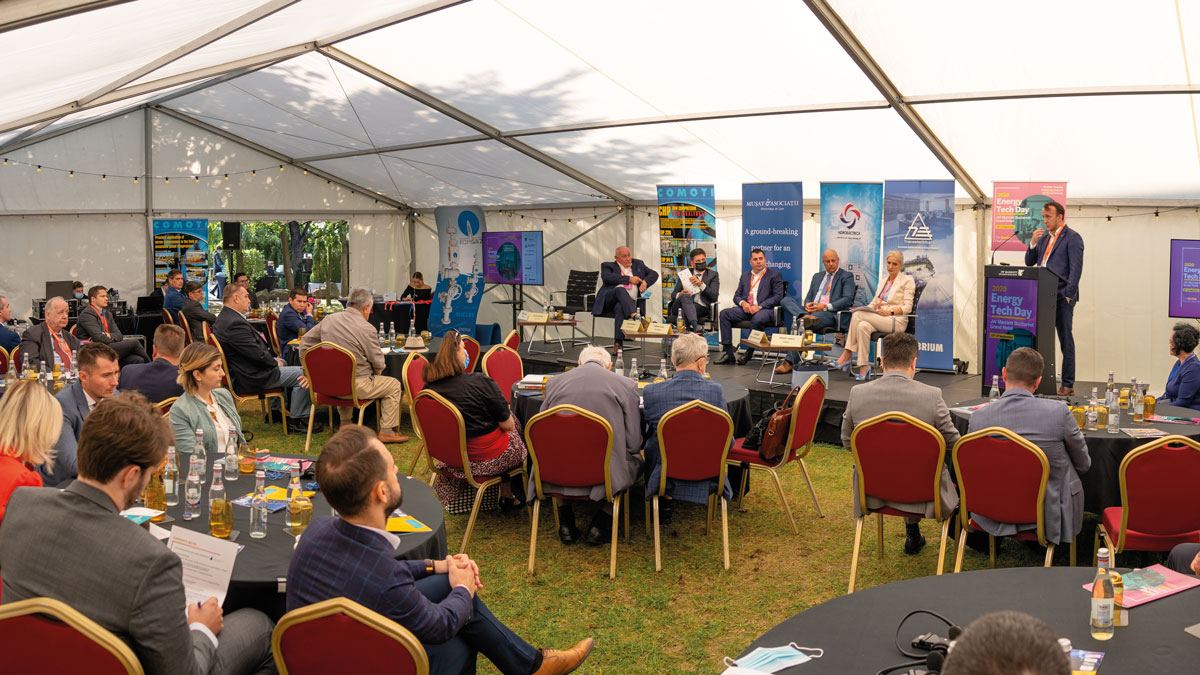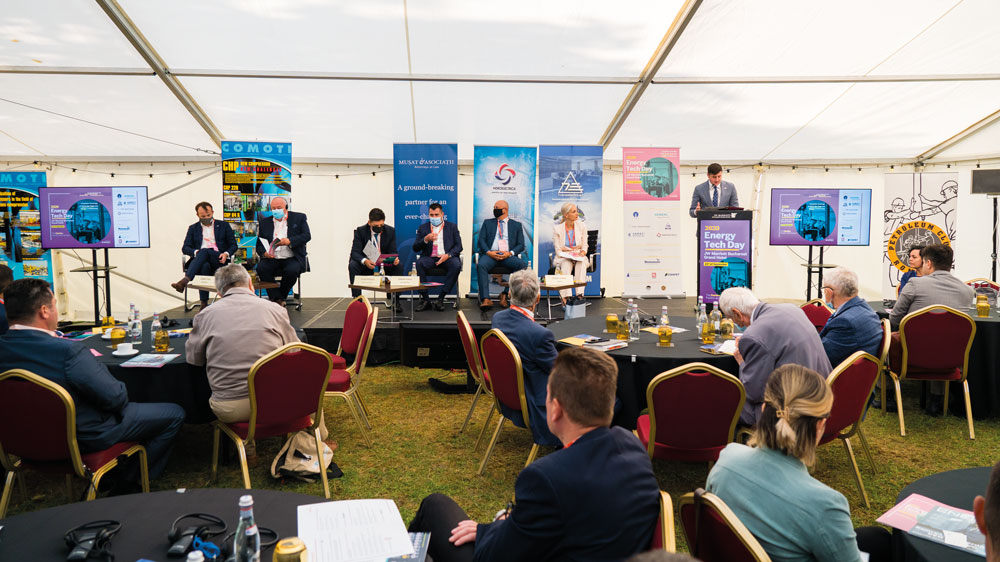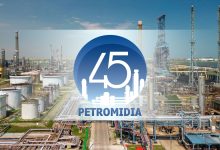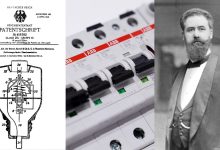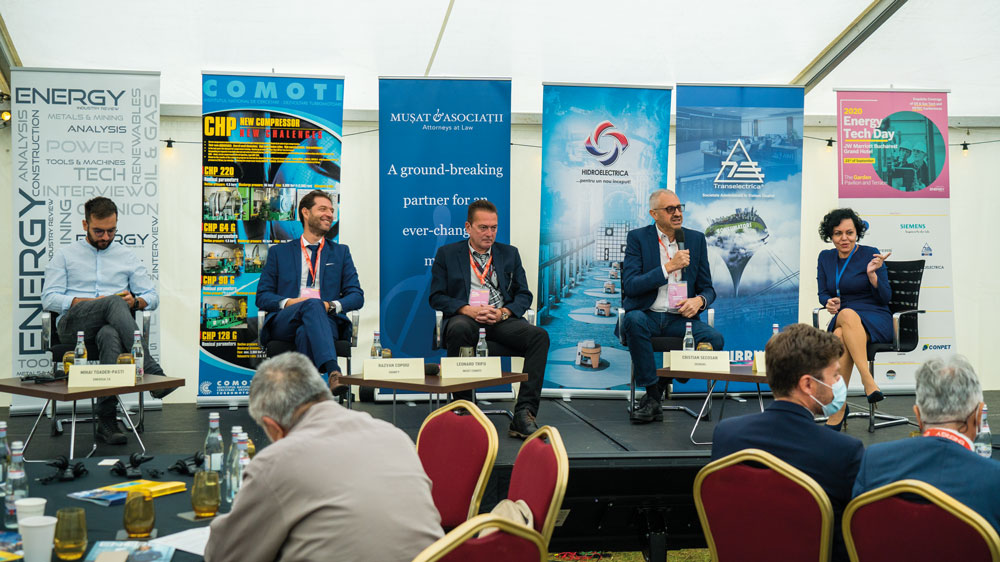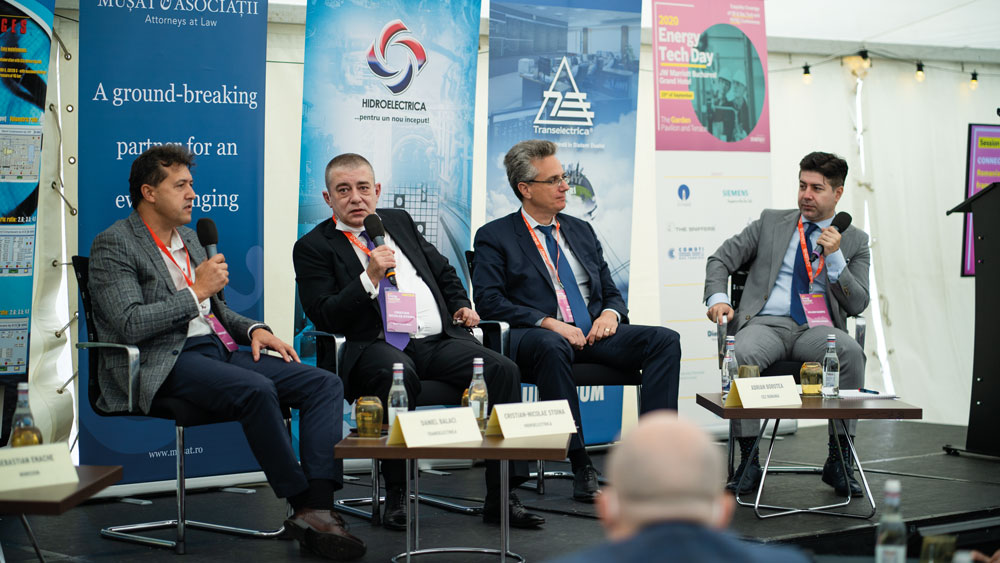Energy Tech Day 2020: Bringing Together Leading Energy Experts
In the time of pandemic, Energy Industry Review has introduced a new conference format – Energy Tech Day 2020, an exquisite coverage of Oil & Gas Tech and Power and Energy Tech conferences.
Energy Tech Day 2020, the communication platform for senior management and top executives working in the energy industry in Romania, brought together leading energy experts and highly skilled professionals to share their experiences on ground-breaking technologies, strategies, and investment programs.
The ‘Role of Oil, Gas and Renewables in a Fast-evolving Energy Market Towards Achieving the 2030 Agenda and Sustainable Development’ was the main theme for this high-level conference – Energy Tech Day 2020, held on September 23, 2020, in Bucharest.
During a 3-session conference, the participants discussed investments, innovation and modernization programs implemented by energy companies to foster or further scale up oil, gas and renewable energy prospects up to 2030, and addressed challenges and opportunities of the energy sector in Romania.
Investments of approximately EUR 22.6bn by 2030
“We are at the start of a new energy paradigm. It is important to adapt together to changes brought by it, in an integrated and flexible manner, for a greener and socially sustainable future. The 2030 Agenda for Sustainable Development and the European Green Deal are opportunities and challenges alike. Together we have the opportunity to develop new energy ecosystems, increase the degree of network interconnection, to decentralize, to invest in people and in digitization, to reach the goal of climate neutrality,” said Lucian Petrica Rusu – State Secretary, GENERAL SECRETARIAT OF THE GOVERNMENT OF ROMANIA, in the opening of the Energy Tech Day 2020.
“For the future of the energy sector, it is important that in the following period most of the profit be reinvested. Moreover, according to the Integrated National Energy and Climate Plan, to reach the targets assumed by Romania, during 2021-2030 total investments of approximately EUR 22.6bn will be necessary. Among sources of funding for them we find structural funds, the InvestEU program, the Just Transition Fund, the Modernization Fund and, obviously, the state budget.
For the following seven years approximately 25% of the EU budget will be directed to projects that contribute to environmental protection and the reduction of carbon dioxide emissions. Energy transmission companies were asked to accelerate projects in this field so that they can be funded including under the European Green Deal.
We currently have a stable, interconnected energy market and we are an important player in the region. But the level of interconnectivity of the national power grid is expected to grow at an accelerated pace, which involves especially investments to increase the capacity and for interconnections. An example is the Overhead Transmission Line Cernavoda-Stalpu project, carried out by Transelectrica, a total investment of over EUR 58mln which involves consolidation of the cross section between the western coast of the Black Sea (eastern Romania) and the rest of the European system. For its part, Transgaz estimates investments of almost EUR 5 billion in the development of the national gas transmission system (NTS) and in the expansion and upgrade of underground storage facilities. Moreover, under the National Investment and Economic Relaunch Plan prepared by the Government of Romania, we plan to allocate in the coming years a total of approximately EUR 15bn for investments in energy and gas,” the official pointed out.
TOWARDS A FUNCTIONAL ENERGY MARKET IN ROMANIA: Prospects for Oil, Gas and Renewables up to 2030
The first session of the Energy Tech Day 2020 was focused on prospects for Oil, Gas and Renewables up to 2030.
Robert Chirca – Deputy General Manager, ROMGAZ, highlighted the most important aspects in company’s activity, the investment programs, as well as the development directions for the following period, emphasizing the role of investments in ensuring a sustainable development. The vision of an integrated company, such as the largest gas producer in Romania, focused on profitability and competitiveness, includes diversification of the business profile, investment in people, ambitious projects and, in particular, focuses on the sustainability strategy. Therefore, within the strategy, Romgaz scheduled for the following period investments of RON 15.7bn. The company aims to maintain its production and reduce its natural decline, considers collaborations with companies active in the Black Sea area and wants to expand the activity in the wind, solar, geothermal, and even biogas areas. Diversification will also take place in the field of petrochemistry, by transforming natural gas into methanol, Romgaz planning to build a Greenfield unit for this purpose.
Projects that cover the electricity area were also mentioned: Iernut power plant, with a capacity of approximately 430 MW, and a new power plant, to be built in Mintia area.
THE SNIFFERS presentation, having as theme ‘Sustainable gas developments in line with the European Green Deal’ focused on strategies for a cost-efficient transformation of the energy sectors by 2030 and monitoring in order to detect emissions in this area of activity and not only.
Considering the goal of climate neutrality by 2050, Adrian Staicu – Regional Manager South East Europe, highlighted a series of initiatives of his company to protect the environment and boost the green economy.
“Energy is an attractive sector to reduce emissions,” notes Adrian Staicu, reminding that methane, the primary focus for O&G industry, is causing 25% of man-made global warming and that methane reductions can have immediate impact. Lowering global O&G methane emissions with 45% would achieve as much climate benefit in the next 20 years as closing 1000 coal plants.
As the world’s biggest importer of natural gas, the EU is facing pressure from investors, climate campaigners and some fossil fuel companies to set binding methane emissions limits on gas sold in Europe. Therefore, the EU plan to curb emissions of methane – Methane Strategy – is long-awaited.
Oana Bucur – Digitalization Task Force Leader, FPPG, brought to the attention of the audience the ‘Necessary regulatory changes to enable Digitalization in the Oil & Gas industry’. The main issue faced by the industry is represented by the fact that certain documentation is classified (e.g. documentation of resources and reserves, concession agreements) under NAMR Order 264/2020, former 202/2003; 2/2013) and classified documentation cannot leave Romania (GD 585/2002 on handling Classified Information). She also stated that best in class technologies such as Cloud Computing, Analytics, which imply storing of data in other countries, cannot be used, leaving the Upstream sector away and behind all other sectors and industries. Therefore, there are a number of opportunities that the industry is missing, such as: fast access to data and models by shortening decision time; reducing processing time of reservoir models; reducing drilling time by real-time monitoring; increasing success rate in exploration and appraisal activities by processing large volumes of seismic data in the Cloud; increasing production; reducing costs.
In terms of proposed solutions, Oana Bucur mentioned the update of the NAMR Order 264/2020 (former Order 202/2003; 2/2013), so that the Upstream data can be excluded from the considered list of classified information, following that Cloud adoption be enabled (possibility to store data outside Romania).
The first Romanian offshore gas development project in the last 33 years – MIDIA GAS DEVELOPMENT (MGD), as well as GSP challenges for the Black Sea, were presented by Bruno Siefken – Senior Vice President, GSP HOLDING. He made a brief of MGD, showing the main characteristics of the project. MGD Project consists of 5 production wells (1 subsea well at Doina field and 4 platform wells at Ana field), a subsea gas production system over the Doina well which will be connected through an 18 km pipeline with a new unmanned production platform located over Ana field. A 121 km subsea pipeline will ensure the delivery of gas from Ana platform to the shore, where a 4.1 km underground pipeline will connect to the new gas treatment plant (GTP). The pipelines of over 120 kilometres will carry gas to Romania and cover 10% of the country’s consumption needs, he added.
The operations are performed with the GSP Bigfoot 1 vessel, a barge with a dynamic positioning system classified under ABS register, for the laying of submarine pipelines and for heavy lift works. The pipelay system is based on the single joint S-lay principle. The barge can install 6’’ to 60’’ diameter pipelines.
Iulian Popescu – Deputy Managing Partner, MUSAT & ASOCIATII, set out to answer the questions: Upgrading the laws – incentive or obstacle in the energy market? Directly negotiated contracts – where to? He defined bilateral power purchase agreements (PPAs), making a brief history thereof in Romania for the period 2001-2020, also mentioning that the Lawmaker has prohibited this practice with the entry into force of the Electricity and Natural Gas Law no. 123/2012 (the Energy Law). However, the current legislative framework at national level, updated by various new regulations, does not provide a clear vision of what will happen as of January 1, 2021, Iulian Popescu said. He also mentioned the two European laws, the Directive 2019/944 and the Regulation 2019/943, which Romania has the obligation to implement. The first sets out rules for the production, transmission, distribution, supply, and storage of electricity, as well as aspects on consumer protection, and focuses more on rules on consumer rights and retail electricity markets. It must be transposed into the national law by January 1, 2021, Romania having the freedom of deciding on how to fulfill the objectives of the Directive. The second reviews the rules and principles of internal market for electricity of the EU; it encourages the free formation of prices and the avoidance of actions that prevent the formation of prices on the basis of supply and demand; and focuses mainly on wholesale market rules and network operation. It will be applicable as of January 1, 2020, has a binding nature and must be applied in its entirety. Failure to comply with the aforementioned shall result in consequences at European Union level, not at all to be neglected, culminating in the inevitable failure to reaching Romania’s target of having a 30.7% share of energy from renewable sources in the final gross energy consumption in 2030. In this situation, the prospects for Romania involve the conclusion of long-term power sale-purchase agreements with customers (PPAs) outside centralized markets and preparing a support mechanism of the Contracts for Difference (CfD) type.
Gabriel Paal – Executive Vice President EU, PROUDFOOT, analyzed the implications of the current crisis period on Upstream, Midstream and Oil Field Services (OFS). Among the most important observations are the following.
In the long-term, companies will focus on shifting to ‘cleaner’ energy options, such as LNG, offshore wind power, and hydrogen.
Midstream will continue to be a value-added component of the O&G industry, we will see some OPEX realignments, consolidation of projects, and towards the end of the decade a broader review of the infrastructure incorporating potentially an increase in digitalization and predictive maintenance.
Most of the oil field service companies were already in a weak balance sheet position following the 2014 crisis. To survive, a radical approach is required, including consolidations, capacity reduction and capability upgrades. This is the time to restructure and look at options such as asset liquidation, supply chain reconfiguration, partnerships, and rapid technological acceleration.
New business will continue to emerge in the energy transition space, but at present it is unclear what form the return for some of these less mature enterprises such as Hydrogen and Carbon Capture will take. The oil and gas majors, as we have seen with recent announcements from Shell and BP, will look to invest in this sector to reduce their carbon footprint.
Proudfoot believes that the common thread that will support the Oil & Gas sector moving forward is the continuing and progressive implementation of digitalization, which will drive efficiency and deliver a greater positive impact to the bottom line, Gabriel Paal concluded.
CONNECTING ENERGY MARKETS: Romania in the regional landscape framework
During the second session of the Energy Tech Day 2020, the debates moved to energy markets, digital transformation, and best solutions for energy transition.
Digital transformation strategy and best solutions for energy transition within the company were the debate topics for Cristian Secosan – CEO Romania and Moldova, SIEMENS.
Therefore, the digital transformation proposed by Siemens integrates hardware, software, and state-of-the-art technologies. To help customers tap the potential of Industry 4.0, Siemens is already providing a portfolio of solutions that includes the main elements of a digital company. Having scalable solutions at hand, companies can invest in Industry 4.0 to digitize in a fully integrated manner the entire chain of the production process.
Digital twin, for example, an integrated data model that can manage the entire production facility, can be implemented including for existing facilities, of brownfield type, increasing flexibility and efficiency.
MindSphere, an open IoT operating system based on cloud technology, creates connection with the Internet of Things. This means that producers can analyze their production facilities and products in use, and the information can be transmitted to the entire chain of the production process, for continuous optimization. MindSphere allows industries around the world to connect their equipment and physical infrastructure to the digital world. Working with several protocols at the same time, it uniquely simplifies the connectivity challenges targeting most of the industry – allowing each company to become a digital enterprise. Gathering data, through MindSphere, from any number of smart devices connected, integrated digitized systems make possible the real-time analysis of operational data. The prospects obtained from this analysis then lead to optimized processes, benefits in terms of resources and productivity, the development of new business models and cutting the costs of operations and maintenance costs.
COMOTI Turbine Engines Research and Development Institute (INCDT COMOTI) – the only unit in Romania specialized in the development and integration of scientific research, constructive and technological design, manufacturing, experimentation, testing, technological transfer and innovation in the field of aviation turbine engines, gas turbine industrial machines and high-speed blade machines – took part in the conference with Customized solutions for natural gas exploitation and transportation.
Referring to energy saving solutions, Leonard Trifu – Marketing Manager, INCDT COMOTI, presented the compression equipment for natural gas: Screw Compressors CU64, CU90, CU128 made under GHH Rand License; Screw Compressors High Pressure CU128, CU200, CU220; Expander – Electric Generator; Centrifugal Oil-free Compressors for air and gas (EGC and CCAE); Power Driver: electric, piston engine or aviation turbine; Skid/Package Assemblies, and gas turbines applications, such as implementation of the 1st Romanian cogeneration power plant (electric and thermal with gas turbines), in cooperation with Pratt & Whitney Canada.
He also pointed out the specialized services offered by COMOTI: Automation for GT, Compressors and Electrical Engineering; Compression and Electrical Equipment Assembling, Maintenance, and Service; 3D Modelling; CFD Analysis – vibration, stress and thermal; Composite parts development; Machining prototypes and small series; Test benches for GT and Compressors; Metrology.
Unlocking the energy efficiency potential of smart lighting was the theme of the presentation delivered by Razvan Copoiu – CEO Romania and South Eastern Europe, SIGNIFY. Signify is the world leader in lighting, providing high quality energy efficient lighting products, systems, and services.
With the rapid urbanization and population growth, cities are facing major challenges. They must ensure safe and quality living spaces for citizens. Yet, at the same time, with limited budgets and resource constraints, they must optimize their operations by embracing sustainable practices and technology such as digitization. More importantly, cities must become smarter so any investment should be future ready types, to take on more innovative scaling.
For example, cities may start with smart lighting, but they may want smart lighting system to fit into a broader smart city agenda, as one of the enabling pillars to provide data/information exchanges digitally, in order to improve the lives of citizens, showed Razvan Copoiu.
Talking about connected lighting, he defined the concept of Interact City – a connected lighting system and management application that enables to remotely manage, monitor, and control all the city lighting.
About Prosumers, connecting people and accelerating the climate transition, talked Mihai Toader-Pasti – Cofounder ENERGIA.TA. The aim of the association is to support prosumers in Romania, in terms of both duration and bureaucracy of the authorization process, and compensation for energy injected into the network. The Prosumer’s Guide was created for this purpose, offering technical, economic details and useful recommendations for those interested in producing energy by themselves, thus accelerating transition to an economy based on clean energy.
Mihai Toader-Pasti highlighted the history of prosumers and the new perspective in Romania. As the Energy Performance of Buildings Directive (EPBD) requires all new buildings from 2021 (public buildings from 2019) to be nearly zero-energy buildings (NZEB), the nearly zero or very low amount of energy required should be covered to a very significant extent from renewable sources, including sources produced on-site or nearby.
The ambitious target, proposed by the association, is that Romania becomes 100% supplied with renewable energy sources.
The last session of the Energy Tech Day 2020 gave prominence to performance, competitiveness, retrofitting processes, investments in new technologies.
In the context of economic transition to clean energy, ‘Improving performance, competitiveness, human potential & assets valuation’, is of particular importance, believes Cristian-Nicolae Stoina – Member of the Supervisory Board, HIDROELECTRICA.
On a market shaken by imbalances on global exchanges and not only, during the pandemic, the companies’ development plans have been negatively affected, suffering inevitable changes. Hidroelectrica, the largest electricity producer of Romania, was no exception. However, figures show an increase in company’s value, having behind seven years of active work, showed Nicolae Stoina.
The company’s ambitious investment program until 2025, which amounts to approx. RON 26bn, provides for several significant objectives, including diversification of the line of business, respectively besides hydropower production, the production of wind power.
Hidroelectrica’s plans include investments in onshore and offshore wind farms, photovoltaic parks, biomass-fired power production, hydrogen production by hydrolysis, development of e-mobility networks. The official also mentioned the projects Enescu – the acquisition of CEZ Romania group, and Scorilo – the acquisition of UCMR Resita assets.
A particular focus continues to be the assessment and perfecting of human resource, adopting integrated business systems, helping to make decisions fast etc. It is also considered to increase the value of assets, many more than 60 years old, through upgrade and retrofitting works.
Digitization is of paramount importance in the energy sector, Daniel Balaci – Director of the Energy Efficiency and New Technologies Division, TRANSELECTRICA, also claims. He gave the example of the pilot project of Alba Iulia substation – the first digital station of the transmission and system operator in Romania.
The company has a key role on the national power market, also ensuring electricity exchanges between the countries of Central and Eastern Europe, as member of ENTSO-E (European Network of Transmission System Operators for Electricity).
Transelectrica’s investment process is continuous, the company’s strategy focusing on new upgrade projects, and for the following period there are plans to build power lines of 400 kV in the west of the country, given the increase in consumption in this area, together with the retrofitting of some substations.
TSOs need continuous investments in new technologies, in upgrading system equipment, in substations and power lines, to ensure clean energy, Daniel Balaci pointed out.
He also mentioned the projects in collaboration with the Polytechnic University of Bucharest and with the Polytechnic University of Timisoara, as well as involvement in various European projects.
Last but not least, Adrian Borotea – Group Strategy & EU Agenda Director, CEZ ROMANIA, showed what Being smart and digital means for CEZ.
The emphasis has been on Oltenia region, where CEZ started the activity approx. 8 years ago. By 2030, Distributie Oltenia would need to be prepared to operate a transformed network, using different capabilities, new systems, and advanced analytics tools.
Some of the challenges are worth mentioning: Pressure on losses (CPT) and network reliability (SAIDI, SAIFI) & Investment transparency and efficiency; Market liberalization & Customer engagement and information, alternative communication channels; Metering data necessary for energy efficiency; Regulation compliance in a low predictable environment; Ageing organization, limited exposure to digital working environment & limited pool of external skilled workforce.
Thus, Distributie Oltenia’s initiatives on new technologies will focus on four main areas to meet 2030 expectations – Smart Grid, Advanced Asset management, Digital processes, and Customer satisfaction.
Meanwhile, the key objectives will include efficient operations by real time control and monitoring of field teams, flexible IT system that allows good response time to business needs, customer programs enabled by high quality analytics, improved network performance indicators, advanced smart grid control and analytics.
Currently, there are 10.000 smart meters installed in Craiova on EU funding, the target being 600k smart meters installed until 2028. GIS Data collection is in progress, estimated to be to be finalized until 2024. Currently, 100/130 stations have been modernized and integrated in SCADA.
We thank all our Partners, Sponsors, Speakers & Attendees for their collective efforts during these challenging times. With the Covid-19 situation, we stand by the industry, as we face uncertain times ahead.
The Energy Tech Day 2020 benefitted from the support of: Romgaz, Siemens, INCDT Comoti, The Sniffers, Transelectrica, Hidroelectrica, Musat & Asociatii, Dietsmann, FPPG, Lukoil, Conpet.


